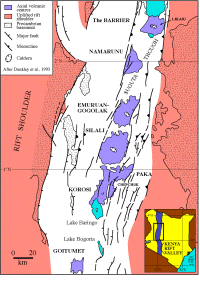Volcanic and Structural Setting of the Rift Valley Floor
The Neogene Kenya rift was preceded by a period of extension in the Oligocene that is best documented in the north, in a broad area that extends from Lake Turkana west to the Lotikipi Plain (Fig. 1; Morley et al., 1992). Reflection seismic data suggest that an older rift, perhaps an arm of this Oligocene rift complex, underlies the Kenya rift valley at least as far south as the region of the Lake Baringo basin (Mugisha et al., 1997). Volcanism associated with the Oligocene rifting began at about 33 Ma, and continued sporadically in time and space to the present (Zanettin et al., 1983; Morley et al., 1992). Initial extension is interpreted to have begun shortly after the onset of volcanism. In a general sense, both volcanism and structuring in the northern rift shifted to the east through time, and became focused along the position of the modern rift valley by the Middle to Late Miocene (Cerling and Powers, 1977; Morley et al., 1992; Bosworth and Maurin, 1993). This culminated with subsidence of the inner rift trough and the development of closely spaced "grid faults" along much of the rift axis starting at about 2 Ma (Baker, 1958; Baker and Mitchell, 1976; Chapman et al., 1978; Baker et al., 1978, 1988; Dunkley et al., 1993).
After formation of the inner rift trough, large areas were flooded with basalt and trachyphonolite lavas, and pyroclastics with associated trachyte lavas were erupted locally as at Chepchuk (northeast of Lake Baringo) and at Likaiu on the Barrier (south end of Lake Turkana) (Fig. 3; Dodson, 1963; Hackman, 1988; Dunkley et al., 1993). During the Late Pleistocene, starting about 1 Ma, numerous axial shield volcanoes were constructed within the inner trough, establishing the present-day geomorphologic character of the rift.
 |
Figure 3.Major faulting and location of axial volcanoes in the northern Kenya rift. After Dunkley et al., 1993. |